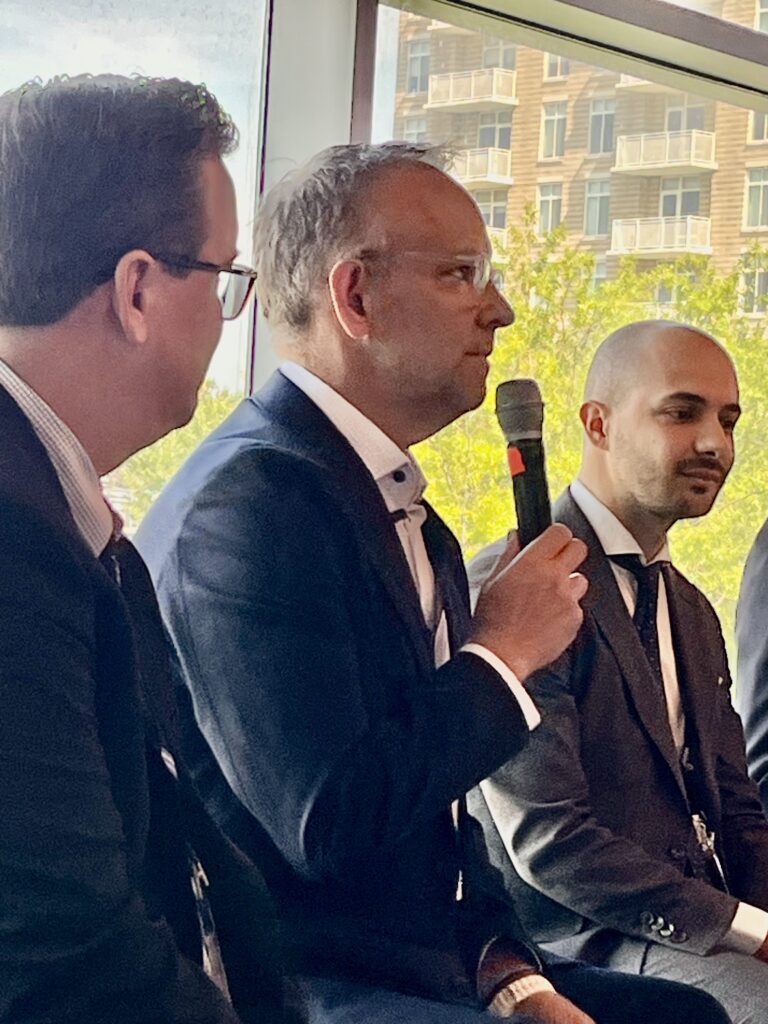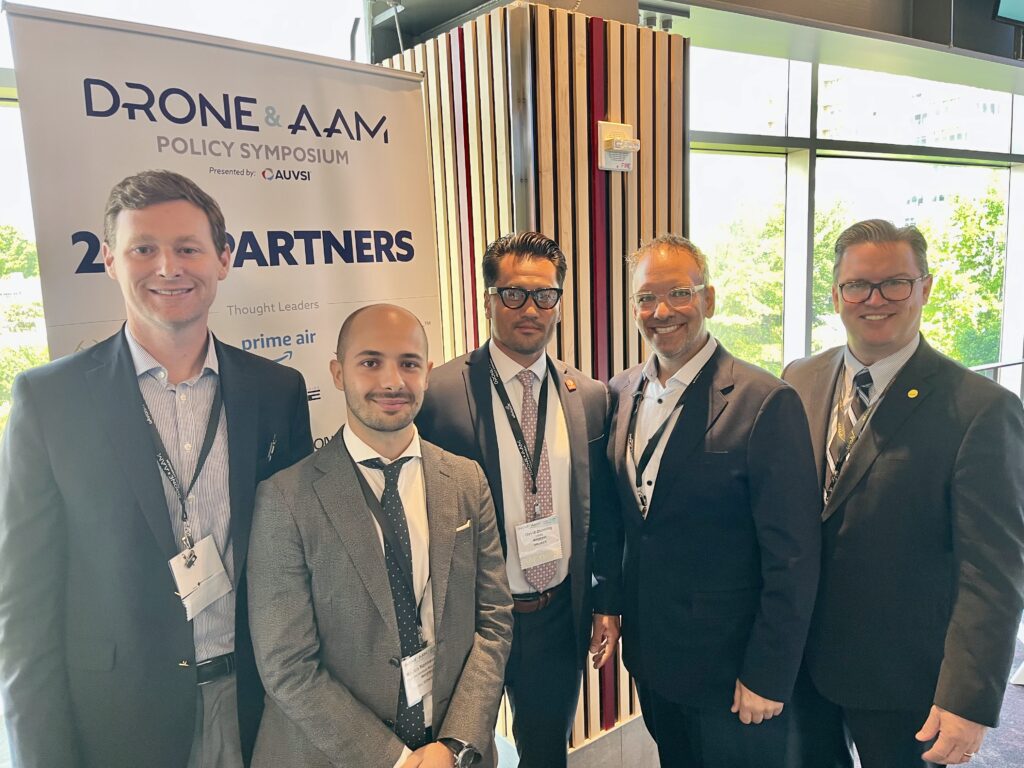At the AUVSI Drone and AAM Policy Symposium’s AAM (advanced air mobility) and SFAR (Special Federal Aviation Regulations) Panel, top voices from the public and private sector—Moderator David Dunning (GAMA), Greg Bowles (Joby Aviation), Rocco Nannavecchia (Pipistrel), David Oord (Wisk Aero), and Alex Simpson (Cassidy & Associates)—provided a rare, unvarnished look at the critical lessons learned from the recent Special Federal Aviation Regulation (SFAR) for powered-lift. With the FAA’s Part 108 NPRM for Beyond Visual Line of Sight (BVLOS) drone flights on the horizon, this session provided vital clues for stakeholders preparing to navigate new regulatory terrain, from those who have been there, done that.
What Is the SFAR—and Why Does It Matter?
SFARs are temporary, flexible frameworks issued by the FAA to fill critical gaps where novel technologies outpace legacy aviation rules. The 2024 SFAR for powered-lift aircraft—signed out by the FAA last November—offers a bridge for the early and safe deployment of AAM vehicles, such as electric vertical takeoff and landing aircraft (eVTOLs), while the agency gathers data and operations to shape permanent rule based on lessons learned from real-world experience. Importantly, the SFAR is not a final rule. It has a 10-year horizon, designed to enable this type of iteration for the FAA, manufacturers and operators. (See prior AG SFAR coverage here).
The SFAR Journey: From Uncertainty to Opportunity
The panelists recounted their involvement in the SFAR’s development. A study in regulatory adaptation and collective perseverance, these power-lift and eVTOL innovators initially assumed they would fit under small airplane rules. As technology leapt ahead, the FAA pivoted to a new powered-lift category. This created sudden uncertainty for original equipment manufacturers (OEMs) and pilots. We went a decade thinking ‘small airplane, small airplane,’ and suddenly it was ‘powered-lift,’” Joby’s Bowles candidly shared.

The industry soon realized a flexible, interim solution—rather than perfection—would be required if innovation weren’t to stall. “You can’t let perfect be the enemy of the good. We landed on a usable, if imperfect, framework that lets the industry move forward and allows regulatory learning,” Bowles explained. “The best part was unlocking the door to allow our industry to thrive and to define the next era of aviation,” he said.
Snafus and the Ex Parte Communications
The panel recounted strict limitations on industry-agency communications after the SFAR’s Notice of Proposed Rulemaking (NPRM) was published. The shift into what some referred to as a “blackout” mode, meant to ensure fair, transparent rule making, ironically left key technical and practical concerns unaddressed, as dialogue ceased.
Oord from Risk lamented, “As soon as the comment period closed, there was a perception, sometimes a reality, that we had no more communication until the final rule. That was uncomfortable for months.”
Pipestrel’s Nannavecchia echoed that keeping channels open is vital. “Collaboration before and during rule making is essential, so regulators truly understand technology and risk. We can’t just go silent.”
While not discussed, it’s possible the FAA over-corrected by shutting down permissible communications during the pendency of the rule, in reaction to the two-year painful litigation involving the agency’s Remote Identification (Remote ID) rule. One of the many allegations in that lawsuit involved perceived unfair discussions with certain industry partners, which were not documented and included in the official record for public comment.
The takeaway for Part 108: Build robust, documented, two-way communication mechanisms, even after the NPRM, so iterative feedback improves rule quality without breaking ex parte protocols.
Not Letting “Perfect” Be the Enemy of Good Innovation
Despite the hurdles, panelists hailed the SFAR’s passage as a “major win.” Besides the FAA, Congress, they noted, played a decisive role, by imposing strict deadlines to prevent regulatory paralysis.

“There was bipartisan recognition we needed to force the FAA’s hand so the industry could flourish. Creating a statutory ‘forcing function’ helped push the SFAR over the finish line,” recalled Simpson.
As a result, the SFAR explicitly recognizes it is not fully comprehensive, especially in areas like pilot certification, operational rules and autonomy. Yet it provides enough structure for the industry to begin scaling safely. “It’s a great first step—but not the end all, be all. It’s a stepping stone, and the industry needs to be vigilant in shaping what’s next,” Simpson noted.
Nannavecchia added, “The SFAR is an incredible testbed… a temporary relief, but also a learning platform. Now the industry and FAA have a decade to iterate and build something that works globally.”
Autonomy Was Missing—And Why It Remains the Next Frontier
The elephant in the regulatory room? Autonomy. The designers of the current SFAR specifically crafted it for piloted, VFR (visual flight rules) operations. As such, it does not address autonomous or remotely supervised flights.
Oord laid out the challenge: “We’re (Wisk) not a piloted aircraft company. The SFAR gives us a foundation, but we need the FAA to layer on autonomy, everything from remote supervision to fully automated flight.”
The path forward may involve a new SFAR or adaptation of current frameworks by an FAA rule making committee. Oord continued, “An aviation rule making committee for autonomy is needed, establishing clear pathways for remote pilot qualification and future move to full autonomy.” (See prior AG coverage where FAA leadership alluded to an Autonomy Working Group here).
Filling this gap remains especially critical as the FAA accelerates plans for BVLOS drone operations presumably for increased drone autonomy, from one-to-many operations to the inclusion of artificial intelligence (AI) in drone systems—in the forthcoming Part 108 framework
How These Lessons Apply to the Imminent Part 108 NPRM
Part 108 should rapidly scale drone flights in the U.S. by routinizing BVLOS drone operations for commercial and public safety applications. The regulatory process for Part 108 seems to be following a similar arc to the SFAR: new technologies, a need for interim guardrails and industry risk if progress stalls.
Even with a reasonable public comment period, it will still take a while for the FAA to adjudicate those comments and publish a final rule. The Remote ID rule, for example, garnered over 50,000 comments and that took the agency almost a year to address. Then a lawsuit stymied the implementation of that rule for another two years. Lessons learned from that experience seem to have spilled over into the SFAR process. As such, the panel outlined several practical tips for the drone sector as it awaits a finalized Part 108.
Start Early and Engage Broadly
Bring stakeholders, including unconventional players, into the discussion at the earliest possible stage. “The strength of the SFAR process was in how industry was able to collectively rally and influence outcomes,” Simpson noted. The drone industry can do this, at this stage, by providing meaningful public comments on the NPRM.
Document and Defend Communication
Anticipate “ex parte blackouts.” The FAA and industry should consider developing structured, traceable communication frameworks and public listening sessions to keep dialogue flowing around technical and operational nuances during the comment period.
Define “Must Haves” Versus “Nice to Haves”
Prioritize essential operational rules, safety requirements and training components. Don’t stall rule making over unresolved or future-looking issues that can be addressed later through amendments or follow-on rules, such as fully autonomous vehicles.
Accept and Plan for Imperfection
The first versions of rule may not be exhaustive or optimal. Waivers, exemptions and “test bed” programs can fill gaps by providing operational experience, so as long as safety isn’t compromised.
Push for Statutory Deadlines
Congressional deadlines and statutory “forcing functions” helped prevent endless regulatory limbo for the SFAR. It appears that advocacy, which resulted in several presidential Executive Orders and Congressional mandates, may have spurred the acceleration of Part 108. If delays continue, keep pushing.
Global Harmonization and Portability
Early international engagement remains critical. “Transferability, not just harmonization, should underpin pilot cert, operational and tech standards,” Nannavecchia urged. He continued, “We want rules that are both global and adaptable. The world will quickly outgrow rigid national solutions.”
Plan for Autonomy Now
Even if autonomy isn’t “solved” in the first iteration of the rule, create flexible frameworks that enable incremental adoption and qualification of remote/AI-led operations, with safety management systems to match.
Data Is Leverage
View and use the SFAR and other similar interim frameworks to propel safe operational results that double as data-gathering exercises to shape future regulation.
Industry-Led Training/Certification
The SFAR shifted operational accountability will from individuals to organizations. Part 108 is expected to do the same. Organizations must be ready to stand up in-house training verification, safety management and compliance regimes. (See prior AG coverage of expected Part 108 training requirements.)
Go for the Good Enough Solution
As the NPRM for Part 108 publication appears to be “imminent,” the drone industry stands at a parallel inflection point as did the AAM sector. The process that propelled their first interim powered lift rule provides the drone industry with a template for action-oriented, flexible and collaborative regulatory development, in terms of balancing the necessary optimism, agility and realism.
Oord said it best: “Not letting perfect be the enemy of the good is what got us a rule.“Now, let the lessons, and the data, shape what comes next.”
So too, the pathway to scalable drone operations will, and should be, iterative—even upon the passage of an NPRM. Usable frameworks, ones that let operations and learning happen will always beat waiting for the perfect answer. That’s as true for AAM as it is for BVLOS.

